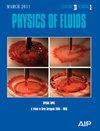Experimental investigation on the vortex-induced vibration response of a lazy-wave flexible riser filled with different fluid media
IF 4.3
2区 工程技术
Q1 MECHANICS
引用次数: 0
Abstract
This paper reports the experimental results of the vortex-induced vibration (VIV) of a lazy-wave flexible riser filled with different fluid media, including the water and helium as typical liquid and light gas examples. The lazy-wave configuration was produced by mounting a buoyancy module of approximately triple the riser diameter on the one-third of the riser length measured from the riser base. The VIV tests were carried out in the depth-averaged reduced velocity (U¯r) range of 9.32–23.19 using the non-intrusive optical measurement with a couple of high-speed cameras. The experimental results indicate that not only the excited mode of in-plane response but also the response amplitude is significantly adjusted when the internal fluid changes, while the excited mode of the out-of-plane response has no obvious modification. Both the water- and helium-filled risers experience the space-varying dominant frequency. However, the helium-filled riser segment possessing a higher dominant frequency is significantly shortened as compared to the water-filled one. When the internal fluid shifts from water to helium, the in-plane mode transition from the first to second becomes incomplete, and the mode transition becomes smoother as U¯r grows. It is found that the starting position of the mode transition is related to the dominant mode as well as the response direction. Then, the influenced length of the riser response from the buoyancy module and the affecting length of the riser on the buoyancy module response are quantified in terms of the spatial distribution of the dominant frequency in comparison with the natural frequencies. The in-plane response of the helium-filled riser is more vulnerable to the oscillation of the buoyancy module, and hence, the coupling between the in-plane and out-of-plane responses is weaker than the water-filled riser. When the impact of buoyancy module on the riser response is enhanced, the reverse effect is weakened.填充不同流体介质的懒波柔性立管涡流诱发振动响应的实验研究
本文报告了填充不同流体介质的懒波柔性立管的涡致振动(VIV)实验结果,包括作为典型液体和轻质气体示例的水和氦气。懒波结构是通过在从立管底部测量的立管长度的三分之一处安装一个浮力模块产生的,浮力模块的直径约为立管直径的三倍。在 9.32-23.19 的深度平均减速度(U¯r)范围内进行了 VIV 试验,使用了几台高速摄像机进行非侵入式光学测量。实验结果表明,当内部流体发生变化时,不仅平面内响应的激发模式会发生明显变化,而且响应振幅也会发生明显变化,而平面外响应的激发模式则没有明显变化。充水立管和充氦立管的主频都会出现空间变化。不过,与充水立管相比,主频较高的充氦立管段明显缩短。当内部流体从水转变为氦气时,平面内第一模式到第二模式的转变变得不完全,随着 U¯r 的增长,模式转变变得更加平滑。研究发现,模式转换的起始位置与主导模式和响应方向有关。然后,根据主频与固有频率的空间分布对比,量化了浮力模块对立管响应的影响长度以及立管对浮力模块响应的影响长度。充氦立管的平面内响应更容易受到浮力模块振荡的影响,因此平面内响应和平面外响应之间的耦合比充水立管弱。当浮力模块对立管响应的影响增强时,反向效应则减弱。
本文章由计算机程序翻译,如有差异,请以英文原文为准。
求助全文
约1分钟内获得全文
求助全文
来源期刊

Physics of Fluids
物理-力学
CiteScore
6.50
自引率
41.30%
发文量
2063
审稿时长
2.6 months
期刊介绍:
Physics of Fluids (PoF) is a preeminent journal devoted to publishing original theoretical, computational, and experimental contributions to the understanding of the dynamics of gases, liquids, and complex or multiphase fluids. Topics published in PoF are diverse and reflect the most important subjects in fluid dynamics, including, but not limited to:
-Acoustics
-Aerospace and aeronautical flow
-Astrophysical flow
-Biofluid mechanics
-Cavitation and cavitating flows
-Combustion flows
-Complex fluids
-Compressible flow
-Computational fluid dynamics
-Contact lines
-Continuum mechanics
-Convection
-Cryogenic flow
-Droplets
-Electrical and magnetic effects in fluid flow
-Foam, bubble, and film mechanics
-Flow control
-Flow instability and transition
-Flow orientation and anisotropy
-Flows with other transport phenomena
-Flows with complex boundary conditions
-Flow visualization
-Fluid mechanics
-Fluid physical properties
-Fluid–structure interactions
-Free surface flows
-Geophysical flow
-Interfacial flow
-Knudsen flow
-Laminar flow
-Liquid crystals
-Mathematics of fluids
-Micro- and nanofluid mechanics
-Mixing
-Molecular theory
-Nanofluidics
-Particulate, multiphase, and granular flow
-Processing flows
-Relativistic fluid mechanics
-Rotating flows
-Shock wave phenomena
-Soft matter
-Stratified flows
-Supercritical fluids
-Superfluidity
-Thermodynamics of flow systems
-Transonic flow
-Turbulent flow
-Viscous and non-Newtonian flow
-Viscoelasticity
-Vortex dynamics
-Waves
 求助内容:
求助内容: 应助结果提醒方式:
应助结果提醒方式:


